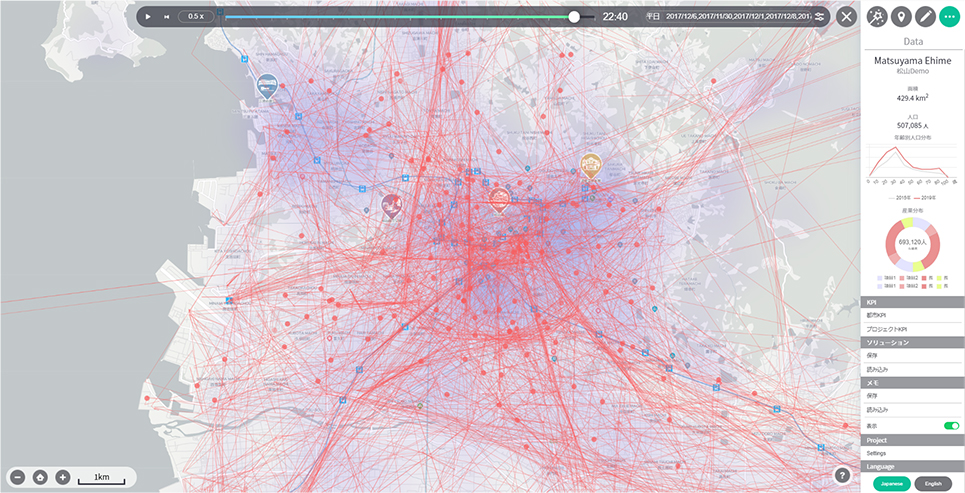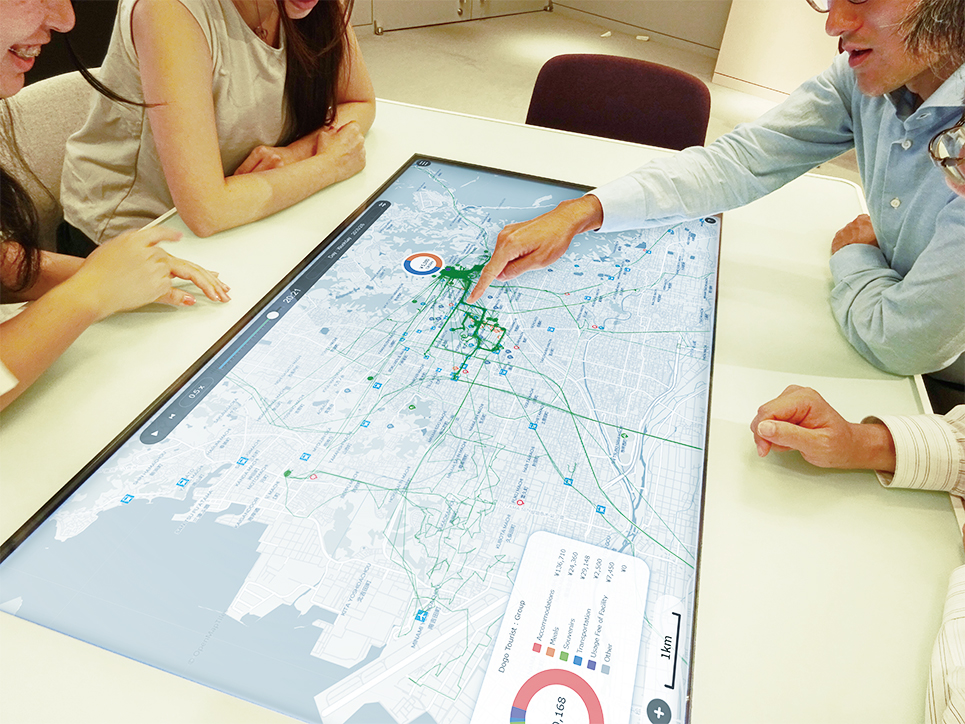
Cyber-PoC for Cities visualizes the situation of the city based on various data.
Text by Reiko Imamura
Abbreviated from Proof of Concept, a PoC simulates project effects or the feasibility of an idea. It is a process performed even before functional prototypes are verified. Hitachi has been conducting R&D and running digital simulations of proofs of concept, or Cyber-PoC. Hitachi and our partners in co-creation use Cyber-PoC to share an understanding of the situation and to simulate the effects of business, so we can discuss the vision of a project. Because different projects, like transportation and finance, require different types of data for simulations, each team used to develop its own custom Cyber-PoC. Solving multifaceted social issues, however, requires greater data integration, and this is why Cyber-PoC for Cities was developed.
Cyber-PoC for Cities is a tool that uses NEXPERIENCE, Hitachi’s co-creation method, to connect widely varied stakeholders in urban development, sparking conversations and supporting consensus building. Designers and researchers together pose the question of how to show what kind of data, testing out these hypotheses for themselves during development.
It is a user interface where the movement of people, statistical data, and other information tied to latitude and longitude can be layered onto one map, and it is planned to be used in three steps. Supposing the objective is to revitalize a shopping district, for example, the tool would enable a team to 1) share an understanding of the current situation and challenges: visualize data useful for grasping the present situation, such as the flow of people in and around the shopping district; 2) envision the community’s future: discuss initiatives while sketching new means of transportation to the district and placing facilities on the map; and 3) estimate and compare effects: compare the initiatives by simulating their implementation and estimating the changes in people’s movement, ease of shopping, the district’s profits, and community vitality.
The tool rapidly carries out a series of processes digitally, but the crucial part of all this is that the tool allows people in different positions to reach a mutual understanding. Not only are the effects of each decision visualized for all to see, but also everyone on the team thinks for themselves and gains empathy through discussions considerate of others’ perspectives. This series of processes must be supported.

Image of using Cyber-PoC for Cities in the workshop.
Currently, Urban Design Center Matsuyama (UDCM), an urban development body of public-private-academic collaboration in Matsuyama, Ehime prefecture, is trying to make use of Cyber-PoC for Cities. Established in 2014 as an organization with an eye to the next-gen version of Matsuyama, UDCM is engaged in social experiments on the use of public spaces and supports planning and consensus building in Matsuyama’s urban development projects. Since 2017, UDCM has also been conducting a joint research on data-driven urban development with H-U Tokyo Lab.
Consensus building is important in urban development. For example, a plan that changes a community’s structure or space will draw different opinions. Data to back every opinion will become vital at this juncture, to move forward with constructive discussions, so various data, like the movement of citizens and tourists, traffic maps, distribution of the elderly, and indicators of livability, were input into the experimental Cyber-PoC for Cities. When introduced to city employees on a trial basis, it received positive feedback such as “The barrier is low thanks to the intuitiveness of its use, like touching a smartphone screen. It can be operated remotely, and I get the feeling residents will have more ways to get involved in urban development.”
The station squares of Matsuyama City Station and JR Matsuyama Station soon to undergo development simultaneously, Cyber-PoC for Cities is expected to be used for the largescale urban management.
For cities across Japan adopting smart city capabilities, the need to visualize current circumstances and simulate policy ideas will likely grow. On the other hand, it’s also important to gain understanding on the use of various data about people. To that end, we need to not only make it grow into a tool that can foster empathy among stakeholders, but also design the process of collaborating with residents and, in combination, establish a method for supporting consensus building.
At Hitachi, our plan is to let various people involved in urban development use Cyber-PoC for Cities, and through demonstrating what we can do and what we want to know with it, continue to upgrade the system for better performance.